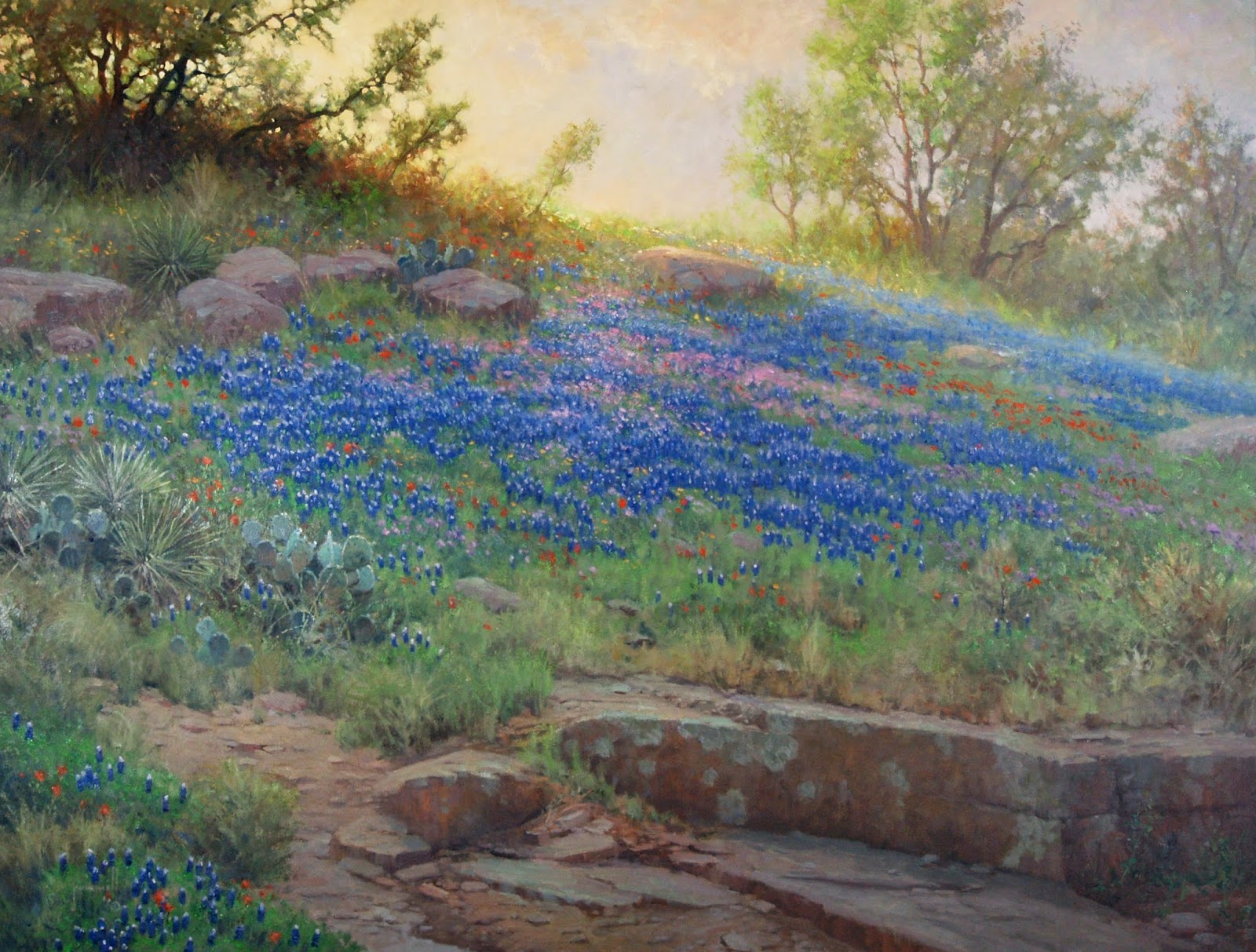Deep In the Art of Texas: A Century of Paintings and Drawings
The following is excerpted from "Deep In the Art of Texas: A Century of Paintings and Drawings", published by the TCU Press and featuring essays by J.P. Bryan, Michael Duty, and Dr. Ron C. Tyler. The book was published in conjunction with an exhibition that will be on view at the Art Museum of South Texas until Jan.4, 2015. The book and exhibition were a collaboration between the Bryan Museum in Galveston, Texas and the Center for Texas Studies at TCU. This excerpt is from my essay, "Frontier Images and Modern Views: The Bryan Museum Collection of Texas Art." I was pleased to serve as guest curator for the exhibition and editor of the book.
 |
| Merritt Mauzey, A Church in Galveston (detail),1935 23"x29", oil on canvas |
1848..jpg) |
| Theodore Gentilz, "Corrida de la Sandia San Antonio (Dia de San Juan)"7"x9.5", 1848, oil on canvas |
Such a persistent dichotomy between entrenched image and modern reality has not been lost on those folks charged with creating a less stereotypical portrait of the state. The city of Houston, for example, has recently embarked on an ad campaign that cleverly points up the differences between what many people think Houston to be and what it, in fact, is. In one television spot, Jim Parsons, the star of the popular series, “The Big Bang Theory,” and a Houston native tells viewers that he has lived in both New York City and Houston and saw more horses in New York and more art in Houston. The ad which is aimed at people beyond both Houston’s and Texas’ borders works precisely because the prevailing image of the city and state is not one that conjures up fine art centers and a long history of artistic development.
 |
| Reid Kendrick Crowell, Portrait of a Black Cowboy, 21.5"x17.5", oil on canvas |
Surprising to some, perhaps, is the fact that the development of a thriving and dynamic art community in Texas is not a particularly recent phenomenon. As the paintings in the current exhibition, Deep In the Art of Texas, Selections from the Bryan Museum Collection, attest, Texas has long been home to talented artists who have created images of the state, its land, people, and culture, that present a multi-faceted, highly diverse, and stylistically varied history of the region. The exhibition is currently on display at the Art Museum of South Texas in Corpus Christi, where it will remain until January 4, 2015. The paintings in the exhibition and the larger collection assembled by the museum’s founder, JP Bryan reveal much about the state’s history and much about its artistic heritage. All of the paintings in the current exhibition will be showcased in the Bryan Museum in Galveston, Texas, which is set to make its debut next spring.
 |
| William Lester, Yellow House, 19.5"x20.75", oil on panel |
 |
| Harry Anthony DeYoung, Pinnacle Rocks in Fort Davis, 1927, 29.5"x34.75", oil on canvas |
 |
| Florence Elliot McClung, Preston Road Farm,1940, 17.5"x19", oil on canvas |
While sheer variety is one hallmark of the Bryan collection, artistic excellence is another. Bryan’s choice of the individual components of the collection reveals a sharp eye and highly developed aesthetic sense. Not only does the collection include works by most of the major figures in early Texas art, but paintings of a high caliber of quality as well. Dawson Dawson-Watson’s Cotton Pickers, is arguably among the artist’s finest works, as is Florence McClung’s Preston Road Farm, and Merritt Mauzey’s A Church in Galveston. Bryan has built a collection that presents a broad overview of Texas art, but also narrow’s the focus to truly exceptional works of art.
Such a combination of the “big picture” view of the whole of early Texas art along with an emphasis on individual masterworks, allows one the opportunity of seeing the great panorama of Texas art unfold, while at the same time concentrating on the contributions of a number of unique artistic talents.
 |
| Robert Jenkins Onderdonk, Market Plaza, 1880, 23.5"x41.5", oil on canvas |
 |
| Dawson Dawson-Watson, Cotton Pickers, 29.5"x39.5", oil on canvas |
Much changed in Texas during the time frame covered by the exhibition and much changed in the world of American art during that same time period. As Texas was poised to enter a new era at the midpoint of the twentieth century, one that would be marked by an increasingly urban population shift, its artists were searching for new ways to express themselves and the themes that had long been rooted in Texas history. That search would naturally lead many away from the styles and techniques of Texas’s earliest artists.
Artists such as Otis Dozier, Everett Spruce, William Lester and Merritt Mauzey refined their skills and developed distinctive styles while living in Dallas, which had surpassed San Antonio by the mid twentieth century as the leading art center in the state. These artists brought new perspectives to many of the subjects and locales that earlier artists had explored. One of the great advantages of the Bryan collection is that it offers dramatic comparisons between traditional and modernist viewpoints. It offers a sweeping overview of early Texas art over a period of time that saw the state move from an era of budding villages and frontier towns to one with booming modern cities. Along the way a complex identity was formed that mixes healthy doses of myth, romance, and reality.
 |
| Robert Julian Onderdonk, Noontime on a Clear Day, Southwest Texas, 1916 9.5"x13.5", oil on canvas mounted on board. |
 |
| Everett Spruce, Big Bend, 1945, 23.25"x35.25", oil on board |
Texas artists have played a key role in both reflecting and developing that identity. Today the art of Texas is as multifaceted as the state itself. Texas artists are a diverse group, hard to categorize, and difficult to pigeonhole. Like their predecessors they contribute to an evolving state personality and offer cogent commentary on that personality. Earlier Texas artists played much the same role. We can see how the state developed through their eyes and their talent at presenting different viewpoints and visions. Those visions are preserved and presented through the Bryan collection which offers a glimpse into a unique environment and history. The Bryan Collection does indeed cover a lot of territory from mountain peaks to coastal towns. It presents a dynamic picture of Texas over a critical period of time, a picture that is sometimes surprising and always fascinating.
(all photos are courtesy of the Bryan Museum, Galveston, TX and the Center for Texas Studies at TCU)



.jpg)




.jpg)

















